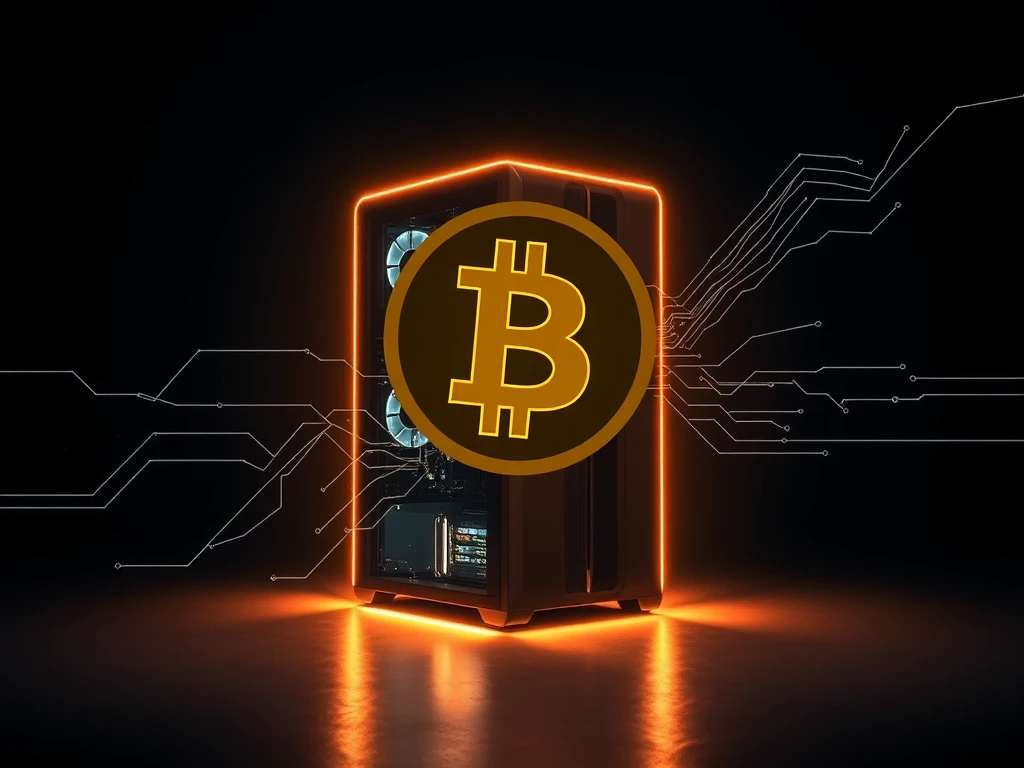Bitcoin Mining: Solo Miner Achieves Incredible $330K Win Against All Odds

Imagine hitting the lottery, but in the world of cryptocurrency. That’s essentially what happened when a single solo miner defied immense odds to solve a Bitcoin block and claim a massive reward. This wasn’t just any block win; it occurred under the most competitive conditions Bitcoin has ever seen, highlighting a fascinating intersection of technology, strategy, and sheer luck in Bitcoin mining.
Understanding the Odds: Why This Solo Miner’s Feat Was Remarkable
On June 5, 2025, a single individual accomplished something truly extraordinary: solving a Bitcoin block entirely on their own. The reward? Over $330,000 in Bitcoin block rewards and transaction fees. What makes this win so notable is the context: it happened when Bitcoin’s mining difficulty was at an all-time high.
Bitcoin mining involves a race to find a specific numerical output (a hash) that meets a network-defined target. The lower the target, the harder the search. At the time of this solo win, the difficulty was such that miners were sifting through over 126 trillion possibilities to find the correct hash.
Even with a temporary surge in computing power—this miner reportedly boosted their hashrate to around 259 petahashes per second (PH/s)—the statistical probability of finding a valid block before the rest of the global network was still incredibly low, roughly 1 in 3,050.
Unlike massive industrial mining farms, this was a single machine submitting hashes through a specialized platform called Solo CKPool. This makes the feat even more striking, demonstrating that while pooled mining dominates, individual success remains possible.
What is Bitcoin Mining, Anyway?
At its core, Bitcoin mining is the engine that drives the network. Miners perform computationally intensive work to verify transactions and add them to the public ledger, the blockchain. Here’s a quick breakdown:
- Miners collect pending transactions into a block.
- They repeatedly hash the block header, changing a small piece of data called a “nonce” with each attempt.
- The goal is to find a hash that is less than or equal to the network’s target difficulty.
- The first miner to find a valid hash broadcasts their block to the network.
- If accepted, the miner earns the block reward (newly minted Bitcoin) and transaction fees.
This process secures the network and introduces new Bitcoin into circulation. The difficulty adjusts periodically to ensure blocks are found, on average, every 10 minutes, regardless of how much total computing power is on the network.
The Strategic Edge: How Rented Hashpower Played a Role
How did one solo miner manage to compete against operations running exahashes of power? The key appears to be rented hashpower. Instead of owning vast amounts of expensive mining hardware, the miner likely leased a significant amount of computing power for a short, targeted period from a cloud mining provider.
This strategy is often called a “take-a-shot” approach. By temporarily directing a massive burst of hashrate towards a solo mining pool like CKPool, the miner dramatically increased their odds for a limited time. If they found a block during this window, the payoff would be substantial, covering the rental cost and yielding a large profit. If not, the cost would be minimal compared to running hardware continuously.
This tactical use of rented hashpower represents an evolving trend in the mining landscape, making high-capacity mining accessible for short, strategic plays, even for those without industrial-scale infrastructure.
Solo Mining vs. Pooling: The All-or-Nothing Gamble via CKPool
The platform used by this miner, Solo CKPool, facilitates solo mining attempts. This differs significantly from traditional mining pools.
- Pooled Mining: Miners combine their hashrate and share block rewards proportionally to their contribution. It offers more frequent, smaller payouts.
- Solo Mining (via CKPool): Miners use their hashrate to try and find a block alone. If successful, they keep the entire block reward. If not, they earn nothing.
This solo win underscores the high-risk, high-reward nature of solo mining. While statistically improbable, especially at high difficulty levels, the potential for a full block reward motivates some miners to take this gamble, often amplified by the strategic use of rented hashrate.
Why Solo Wins Matter in Today’s Mining Landscape
This $330K win, along with other rare solo successes seen even in 2025, sends a powerful message about the adaptability of Bitcoin mining. Even as difficulty reaches record highs and large operations dominate, strategic approaches can still yield significant results for individual participants.
These events highlight:
- The continued, albeit rare, viability of solo mining, particularly when combined with innovative tactics like renting hashpower.
- The growing role of cloud mining services that enable on-demand access to significant computational power.
- That mining isn’t solely about raw, constant hashrate but also about strategy, timing, and resource access.
While large pools still process the vast majority of blocks, these solo wins serve as compelling examples that the opportunity, however slim, for individual success in Bitcoin mining persists, inspiring others to explore non-traditional strategies.
Conclusion: The Enduring Appeal of Beating the Odds
The story of the solo miner winning a $330K Bitcoin block against overwhelming odds is a testament to the dynamic nature of the Bitcoin network. It shows that even in a highly competitive and mature environment, clever strategy and temporary access to resources like rented hashpower can create opportunities for outsized returns. While solo wins via platforms like CKPool remain rare statistical anomalies, each success reinforces the idea that the game of Bitcoin mining isn’t exclusively reserved for the industrial giants. The odds are long, but as this miner proved, they are not impossible, and that alone keeps the dream alive for others.









